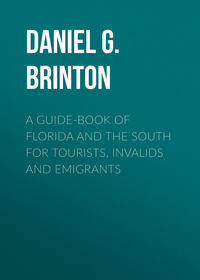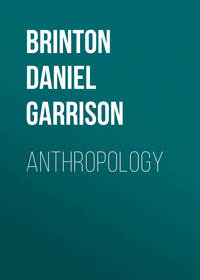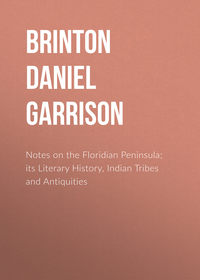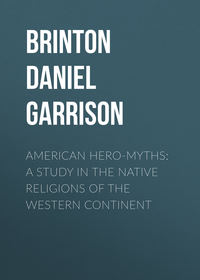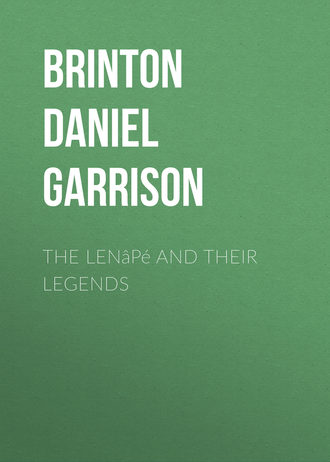 полная версия
полная версияThe Lenâpé and their Legends

Daniel G. Brinton
The Lenâpé and their Legends
PREFACE
In the present volume I have grouped a series of ethnological studies of the Indians of Eastern Pennsylvania, New Jersey and Maryland, around what is asserted to be one of the most curious records of ancient American history.
For a long time this record – the Walam Olum, or Red Score – was supposed to have been lost. Having obtained the original text complete about a year ago, I printed a few copies and sent them to several educated native Delawares with a request for aid in its translation and opinions on its authenticity. The results will be found in the following pages.
The interest in the subject thus excited prompted me to a general review of our knowledge of the Lenape or Delawares, their history and traditions, their language and customs. This disclosed the existence of a number of MSS. not mentioned in bibliographies, some in the first rank of importance, especially in the field of linguistics. Of these I have made free use.
In the course of these studies I have received suggestions and assistance from a number of obliging friends, among whom I would mention the native Delawares, the Rev. Albert Anthony, and the Rev. John Kilbuck; Mr. Horatio Hale and the Right Rev. E. de Schweinitz; Dr. J. Hammond Trambull, Prof. A. M. Elliott and Gen. John Mason Brown.
Not without hesitation do I send forth this volume to the learned world. Regarded as an authentic memorial, the original text of the Walam Olum will require a more accurate rendering than I have been able to give it; while the possibility that a more searching criticism will demonstrate it to have been a fabrication may condemn as labor lost the pains that I have bestowed upon it. Yet even in the latter case my work will not have been in vain. There is, I trust, sufficient in the volume to justify its appearance, apart from the Red Score; and the latter, by means of this complete presentation, can now be assigned its true position in American archaeology, whatever that may be.
CHAPTER I
§ 1. The Algonkin Stock.
Scheme of its Dialects – Probable Primitive Location
§ 2. The Iroquis Stock.
The Susquehannocks – The Hurons – The Cherokees
§ 1. The Algonkin StockAbout the period 1500-1600, those related tribes whom we now know by the name of Algonkins were at the height of their prosperity. They occupied the Atlantic coast from the Savannah river on the south to the strait of Belle Isle on the north. The whole of Newfoundland was in their possession; in Labrador they were neighbors to the Eskimos; their northernmost branch, the Crees, dwelt along the southern shores of Hudson Bay, and followed the streams which flow into it from the west, until they met the Chipeways, closely akin to themselves, who roamed over the water shed of Lake Superior. The Blackfeet carried a remote dialect of their tongue quite to the Rocky Mountains; while the fertile prairies of Illinois and Indiana were the homes of the Miamis. The area of Ohio and Kentucky was very thinly peopled by a few of their roving bands; but east of the Alleghanies, in the valleys of the Delaware, the Potomac and the Hudson, over the barren hills of New England and Nova Scotia, and throughout the swamps and forests of Virginia and the Carolinas, their osier cabins and palisadoed strongholds, their maize fields and workshops of stone implements, were numerously located.
It is needless for my purpose to enumerate the many small tribes which made up this great group. The more prominent were the Micmacs of Nova Scotia, the Abnakis of Maine, the Pequots and Narragansets, in New England, the Mohegans of the Hudson, the Lenape on the Delaware, the Nanticokes around Chesapeake Bay, the Pascataway on the Potomac, and the Powhatans and Shawnees further south; while between the Great Lakes and the Ohio river were the Ottawas, the Illinois, the Pottawatomies, the Kikapoos, Piankishaws, etc.
The dialects of all these were related, and evidently at some distant day had been derived from the same primitive tongue. Which of them had preserved the ancient forms most closely, it may be premature to decide positively, but the tendency of modern studies has been to assign that place to the Cree – the northernmost of all.
We cannot erect a genealogical tree of these dialects. It is not probable that they branched off, one after another, from a common stock. The ancient tribes each took their several ways from a common centre, and formed nuclei for subsequent development. We may, however, group them in such a manner as roughly to indicate their relationship. This I do on the following page: —
Cree,
Old Algonkin,
Montagnais.
Chipeway,
Ottawa,
Pottawattomie,
Miami,
Peoria,
Pea,
Piankishaw,
Kaskaskia,
Menominee,
Sac,
Fox,
Kikapoo.
Sheshatapoosh,
Secoffee,
Micmac,
Melisceet,
Etchemin,
Abnaki.
Mohegan,
Massachusetts,
Shawnee,
Minsi, }
Unami, }
Unalachtigo,}
Nanticoke,
Powhatan,
Pampticoke.
Blackfoot,
Gros Ventre,
Sheyenne.
Granting, as we must, some common geographical centre for these many dialects, the question where this was located becomes an interesting one.
More than one attempt to answer it has been made. Mr. Lewis H. Morgan thought there was evidence to show that the valley of the Columbia river, Oregon, "was the initial point from which the Algonkin stock emigrated to the great lake region and thence to the Atlantic coast."[1] This is in direct conflict with the evidence of language, as the Blackfoot or Satsika is the most corrupt and altered of the Algonkin dialects. Basing his argument on this evidence, Mr. Horatio Hale reaches a conclusion precisely the reverse of that of Morgan. "The course of migration of the Indian tribes," writes Mr. Hale, "has been from the Atlantic coast westward and southward. The traditions of the Algonkins seem to point to Hudson's Bay and the coast of Labrador."[2] This latter view is certainly that which accords best with the testimony of language and of history.
We know that both Chipeways and Crees have been steadily pressing westward since their country was first explored, driving before them the Blackfeet and Dakotas.[3]
The Cree language is built up on a few simple, unchangeable radicals and elementary words, denoting being, relation, energy, etc.; it has extreme regularity of construction, a single negative, is almost wholly verbal and markedly incorporative, has its grammatical elements better defined than its neighbors, and a more consistent phonetic system.[4] For these and similar reasons we are justified in considering it the nearest representative we possess of the pristine Algonkin tongue, and unless strong grounds to the contrary are advanced, it is proper to assume that the purest dialect is found nearest the primeval home of the stock.
§ 2. The Iroquois StockSurrounded on all sides by the Algonkins were the Iroquois, once called the Five or Six Nations. When first discovered they were on the St. Lawrence, near Montreal, and in the Lake Region of Central New York. Various other, tribes, not in their confederacy, and generally at war with them, spoke dialects of the same language. Such were the Hurons or Wyandots, between the Georgian Bay and Lake Erie, the Neutral Nation on the Niagara river, the Eries on the southern shore of the lake of that name, the Nottoways in Virginia, and the Tuscaroras in North Carolina. The Cherokees, found by the whites in East Tennessee, but whose national legend, carefully preserved for generations, located them originally on the head waters of the Ohio, were a remote offshoot of this same stem.
The SusquehannocksThe valley of the Susquehanna river was occupied by a tribe of Iroquois lineage and language, known as the Susquehannocks, Conestogas and Andastes. The last name is Iroquois, from andasta, a cabin pole. By some, "Susquehannock" has also been explained as an Iroquois word, but its form is certainly Algonkin. The terminal k is the place-sign, hanna denotes a flowing stream, while the adjectival prefix has been identified by Heckewelder with schachage, straight, from the direct course of the river near its mouth, and by Mr. Guss with woski, new, which, he thinks, referred to fresh or spring water.
Of these the former will appear the preferable, if we allow for the softening of the gutturals, which was a phonetic trait of the Unami dialect of the Lenape.
The Susquehannocks were always at deadly feud with the Iroquois, and between wars, the smallpox and the whites, they were finally exterminated. The particulars of their short and sad history have been presented with his characteristic thoroughness by Dr. John G. Shea,[5] and later by Prof. N. L. Guss.[6] They were usually called by the Delawares Mengwe, which was the term they applied to all the Iroquois-speaking tribes.[7] The English corrupted it to Minqua and Mingo, and as the eastern trail of the Susquehannocks lay up the Conestoga Creek, and down the Christina, both those streams were called "Mingo Creek" by the early settlers.
It is important for the ethnology of Pennsylvania, to understand that at the time of the first settlement the whole of the Susquehanna Valley, from the Chesapeake to the New York lakes, was owned and controlled by Iroquois-speaking tribes. A different and erroneous opinion was expressed by Heckewelder, and has been generally received. He speaks of the Lenape Minsi as occupying the head waters of the Susquehanna. This was not so in the historic period.
The claims of the Susquehannocks extended down the Chesapeake Bay on the east shore, as far as the Choptank River, and on the west shore as far as the Patuxent. In 1654 they ceded to the government of Maryland their southern territory to these boundaries.[8] The first English explorers met them on the Potomac, about the Falls, and the Pascatoways were deserting their villages and fleeing before them, when, in 1634, Calvert founded his colony at St. Mary's.
Their subjection to the Five Nations took place about 1680, and it was through the rights obtained by this conquest that, at the treaty of Lancaster, 1744, Canassatego, the Onondaga speaker for the Nation, claimed pay from the government of Maryland for the lands on the Potomac, or, as that river was called in his tongue, the Cohongorontas.
The HuronsThe Hurons, Wyandots, or Wendats, were another Iroquois people, who seem, at some remote epoch, to have come into contact with the Lenape. The latter called them Delamattenos[9] and claimed to have driven them out of a portion of their possessions. A Chipeway tradition also states that the Hurons were driven north from the lake shores by Algonkin tribes.[10] We know, from the early accounts of the Jesuits, that there was commercial intercourse between them and the tribes south of the lakes, the materials of trade being principally fish and corn.[11] The Jesuit Relations of 1648 contain quite a full account of a Huron convert who, in that year, visited the Lenape on the Delaware River, and had an interview with the Swedish Governor, whom he took to task for neglecting the morals of his men.
The CherokeesThe Cherokees were called by the Delawares Kittuwa (Kuttoowauw, in the spelling of the native Aupaumut). This word I suppose to be derived from the prefix, kit, great, and the root tawa (Cree, yette, tawa), to open, whence tawatawik, an open, i. e., uninhabited place, a wilderness (Zeisberger).
The designation is geographical. According to the tradition of the Cherokees, they once lived (probably about the fourteenth century) in the Ohio Valley, and claimed to have been the constructors of the Grave Creek and other earthworks there.[12] Some support is given to this claim by the recent linguistic investigations of Mr. Horatio Hale,[13] and the archaeological researches of Prof. Cyrus Thomas.[14] They were driven southward by their warlike neighbors, locating their council fire first near Monticello, Va., and the main body reaching East Tennessee about the close of the fifteenth century. As late as 1730 some of them continued to live east of the Alleghanies, while, on the other hand, it is evident, from the proper names preserved by the chroniclers of De Soto's expedition (1542), that at that period others held the mountains of Northern Georgia. To the Delawares they remained kit-tawa-wi, inhabitants of the great wilderness of Southern Ohio and Kentucky.
Delaware traditions distinctly recalled the period when portions of the Cherokees were on the Ohio, and recounted long wars with them.[15] When the Lenape assumed the office of peacemaker, this feud ceased, and was not renewed until the general turmoil of the French-Indian wars, 1750-60. After this closed, in 1768, the Cherokees sought and effected a renewal of their peaceful relations with the Delawares, and in 1779 they even sent a deputation of "condolence" to their "grandfather," the Lenape, on the death of the head chief, White Eyes.[16]
CHAPTER II
The Wapanachki or Eastern Algonkin Confederacy
The Confederated Tribes – The Mohegans – The Nanticokes – The Conoys – The Shawnees – The Saponies – The Assiwikalees
The Confederated TribesAll the Algonkin nations who dwelt north of the Potomac, on the east shore of Chesapeake Bay, and in the basins of the Delaware and Hudson rivers, claimed near kinship and an identical origin, and were at times united into a loose, defensive confederacy.
By the western and southern tribes they were collectively known as Wapanachkik– "those of the eastern region" – which in the form Abnaki is now confined to the remnant of a tribe in Maine. The Delawares in the far West retain traditionally the ancient confederate name, and still speak of themselves as "Eastlanders" —O-puh-narke. (Morgan.)
The members of the confederacy were the Mohegans (Mahicanni) of the Hudson, who occupied the valley of that river to the falls above the site of Albany, the various New Jersey tribes, the Delawares proper on the Delaware river and its branches, including the Minsi or Monseys, among the mountains, the Nanticokes, between Chesapeake Bay and the Atlantic, and the small tribe called Canai, Kanawhas or Ganawese, whose towns were on tributaries of the Potomac and Patuxent.
That all these were united in some sort of an alliance, with the Delawares at its head, is not only proved by the traditions of this tribe itself, but by the distinct assertion of the Mohegans and others, and by events within historical times, as the reunion of the Nanticokes, New Jersey and Eastern Indians with the Delawares as with the parent stem.[17]
The MohegansThe Mohegans, Mo-hé-kun-ne-uk, dwelt on the tide-waters of the Hudson, and from this their name was derived. Dr. Trumbull, indeed, following Schoolcraft, thinks that they "took their tribal name from maingan, a wolf, and Moheganick = Chip. maniganikan, 'country of wolves.'"[18] They, themselves, however, translate it, "seaside people," or more fully, "people of the great waters which are constantly ebbing or flowing."[19] The compound is machaak, great, hickan, tide ("ebbing tide," Zeis; "tide of flood," Campanius) and ik, animate plural termination.
The Mohegans on the Hudson are said to have been divided into three phratries, the Bear, the Wolf and the Turtle, of whom the Bear had the primacy.[20] Mr. Morgan, however, who examined, in 1860, the representatives of the nation in Kansas,[21] discovered that they had precisely the same phratries as the Delawares, that is the Wolf, the Turtle, and the Turkey, each subdivided into three or four gentes. He justly observes that this "proves their immediate connection with the Delawares and Munsees by descent," and thus renders their myths and traditions of the more import in the present study.
Linguistically, the Mohegans were more closely allied to the tribes of New England than to those of the Delaware Valley. Evidently, most of the tribes of Massachusetts and Connecticut were comparatively recent offshoots of the parent stem on the Hudson, supposing the course of migration had been eastward.
In some of his unpublished notes Mr. Heckewelder identifies the Wampanos, who lived in Connecticut, along the shore of Long Island Sound, and whose council fire was where New Haven now stands, as Mohegans, while the Wapings or Opings of the Northern Jersey shore were a mixed clan derived from intermarriages between Mohegans and Monseys.[22]
The NanticokesThe Nanticokes occupied the territory between Chesapeake Bay and the ocean, except its southern extremity, which appears to have been under the control of the Powhatan tribe of Virginia.
The derivation of Nanticoke is from the Delaware Unéchtgo, "tide-water people," and is merely another form of Unalachtgo, the name of one of the Lenape sub-tribes. In both cases it is a mere geographical term, and not a national eponym.
In the records of the treaty at Fort Johnston, 1757, the Nanticokes are also named Tiawco. This is their Mohegan name, Otayãchgo, which means "bridge people," or bridge makers, the reference being to the skill with which the Nanticokes could fasten floating logs together to construct a bridge across a stream. In the Delaware dialect this was Tawachguáno, from taiachquoan, a bridge. The latter enables us to identify the Tockwhoghs, whom Captain John Smith met on the Chesapeake, in 1608, with the Nanticokes. The Kuscarawocks, whom he also visited, have been conclusively shown by Mr. Bozman[23] to have been also Nanticokes.
By ancient traditions, they looked up to the Lenape as their "grandfather," and considered the Mohegans their "brethren."[24] That is, they were, as occasion required, attached to the same confederacy.
In manners and customs they differed little from their northern relatives. The only peculiarity in this respect which is noted of them was the extravagant consideration they bestowed on the bones of the dead. The corpse was buried for some months, then exhumed and the bones carefully cleaned and placed in an ossuary called man-to-kump (= manito, with the locative termination, place of the mystery or spirit).
When they removed from one place to another these bones were carried with them. Even those who migrated to northern Pennsylvania, about the middle of the last century, piously brought along these venerable relics, and finally interred them near the present site of Towanda, whence its name, Tawundeunk, "where we bury our dead."[25]
Their dialect varied considerably from the Delaware; of which it is clearly a deteriorated form. It is characterized by abbreviated words and strongly expirated accents, as tah! quah! quak! su, short; quah! nah! qut, long.
Our knowledge of it is limited to a few vocabularies. The earliest was taken down by Captain John Smith, during his exploration of the Chesapeake. The most valuable is one obtained by Mr. William Vans Murray, in 1792, from the remnant in Maryland. It is in the library of the American Philosophical Society, and has never been correctly or completely printed.
The Nanticokes broke up early. Between the steady encroachments of the whites and the attacks of the Iroquois they found themselves between the upper and the nether millstones.
According to their own statement to Governor Evans, at a conference in 1707, they had at that time been tributary to the latter for twenty-seven years, i. e., since 1680. Their last head chief, or "crowned king," Winicaco, died about 1720. A few years after this occurrence bands of them began to remove to Pennsylvania, and at the middle of the century were living at the mouth of the Juniata, under the immediate control of the Iroquois. Thence they removed to Wyoming, and in 1753, "in a fleet of twenty-five canoes," to the Iroquois lands in western New York. Others of their nation were brought there by the Iroquois in 1767; but by the close of the century only five families survived in that region.[26]
A small band called the Wiwash remained on Goose creek, Dorchester county, Maryland, to the same date.
The ConoysThe fourth member of the Wapanachki was that nation variously called in the old records Conoys, Ganawese or Canaways, the proper form of which Mr. Heckewelder states to be Canai.[27]
Considerable obscurity has rested on the early location and affiliation of this people. Mr. Heckewelder vaguely places them "at a distance on the Potomac," and supposes them to have been the Kanawhas of West Virginia.[28] This is a loose guess. They were, in fact, none other than the Piscataways of Southern Maryland, who occupied the area between Chesapeake Bay and the lower Potomac, about St. Mary's, and along the Piscataway creek and Patuxent river.
Proof of this is furnished by the speech of their venerable head chief, "Old Sack," at a conference in Philadelphia in 1743.[29] His words were: "Our forefathers came from Piscatua to an island in Potowmeck; and from thence down to Philadelphia, in old Proprietor Penn's time, to show their friendship to the Proprietor. After their return they brought down all their brothers from Potowmeck to Conejoholo, on the east side Sasquehannah, and built a town there."
This interesting identification shows that they were the people whom Captain John Smith found (1608) in numerous villages along the Patuxent and the left bank of the lower Potomac. The local names show them to have been of Algonkin stock and akin to the Nanticokes.
Conoy, Ganawese, Kanawha, are all various spellings of a derivative from an Algonkin root, meaning "it is long" (Del. guneu, long, Cree kinowaw, it is long,) and is found applied to various streams in Algonkin territory.[30]
Piscataway, or Pascatoway, as it is spelled in the early narratives, also recurs as a local name in various parts of the Northern States. It is from, the root pashk, which means to separate, to divide. Many derivatives from it are in use in the Delaware tongue. In the Cree we have the impersonal form, pakestikweyaw, or the active animate pasketiwa, in the sense of "the division or branch of a river."[31] The site of Kittamaquindi (kittamaque-ink, Great Beaver Place,) the so-called "metropolis of Pascatoe,"[32] was where Tinker's creek and Piscataway creek branch off from their common estuary, about fifteen miles south of Washington city.
The "emperor" Chitomachen, Strong Bear (chitani, strong, macha, bear), who bore the title Tayac (Nanticoke, tallak, head chief) ruled over a dominion which extended about 130 miles from east to west.
The district was thinly peopled. On the upper shores of the west side of the Chesapeake Captain John Smith and the other early explorers found scarcely any inhabitants. In 1631 Captain Henry Fleet estimated the total number of natives "in Potomack and places adjacent," at not over 5000 persons.[33] This included both sides of the river as high up as the Falls, and the shores of Chesapeake Bay.
Chitomachen, with his family, was converted to the Catholic faith in 1640, by the exertions of the Jesuit missionary, Father Andrew White, but died the year after. When the English first settled at St. Mary's, the tribe was deserting its ancient seats, through fear of the Susquehannocks, and diminished rapidly after that date.
Father White was among them from 1634 to 1642, and composed a grammar, dictionary and catechism of their tongue. Of these, the catechism is yet preserved in manuscript, in the library of the Domus Professa of the Jesuits, in Rome. It would be a great benefit to students of Algonkin dialects to have his linguistic works sought out and published. How far his knowledge of the language extended is uncertain. In a letter from one of the missionaries, dated 1642, who speaks of White, the writer adds: "The difficulty of the language is so great that none of us can yet converse with the Indians without an interpreter."[34]




